
Representation with a Hyphen: Latinas in the Fight for Women's Suffrage
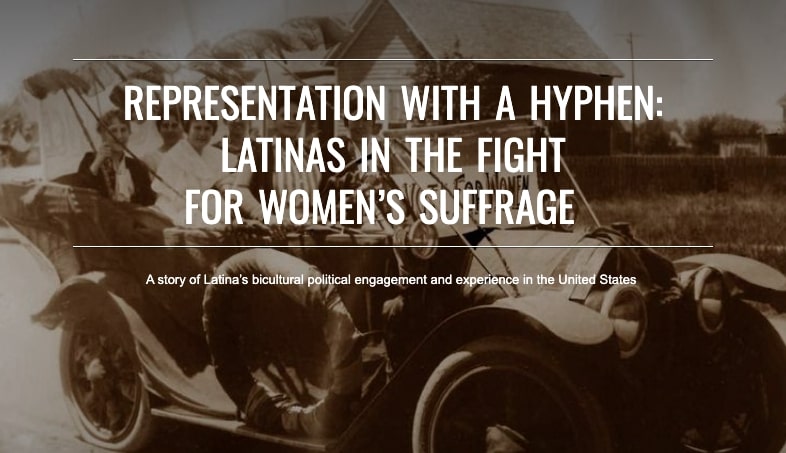
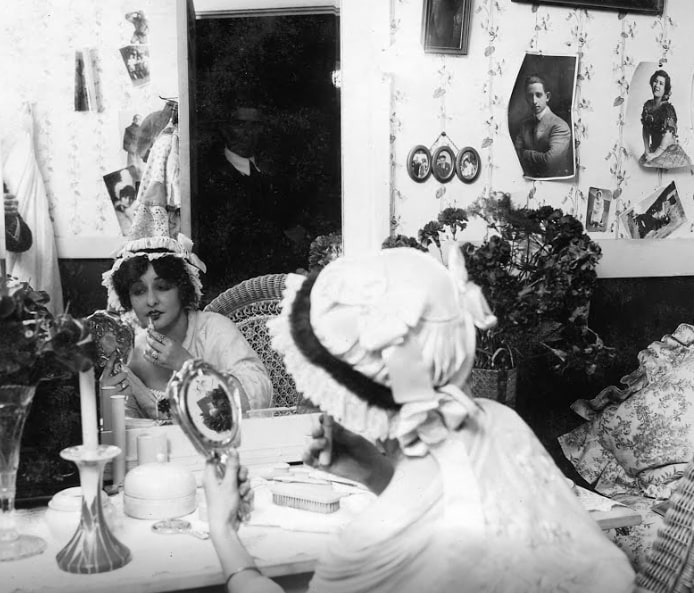 Lucretia del Valle
Lucretia del ValleCourtesy of David “Bodie” Bailey Family Archives | National Women’s History Museum
At just nineteen years of age, Lucretia del Valle took center stage embodying the role of Señora Yorba in John Stevens McGroarty’s famous The Mission Play in 1912. Her casting was a deliberate one. Portraying the story of California’s early missions, del Valle brought to her role a rich Californio heritage as a descendant of the early Spanish-Mexican settlers of the state. Dressed up in her family’s heirlooms, del Valle emphasized her “Spanish” past as a direct tie to the persona of Señora Yorba and the role of Spanish-speaking Catholic missionaries in bringing “civilization” to the state. Through her performance, she seized this opportunity as a chance to authenticate Spanish-Mexicans' claim to belonging and citizenship in the state by alluding to their role in the early settlement of the state. Her portrayal of Señora Yorba was ultimately a political statement and an example of the broad range of Latina political activism.
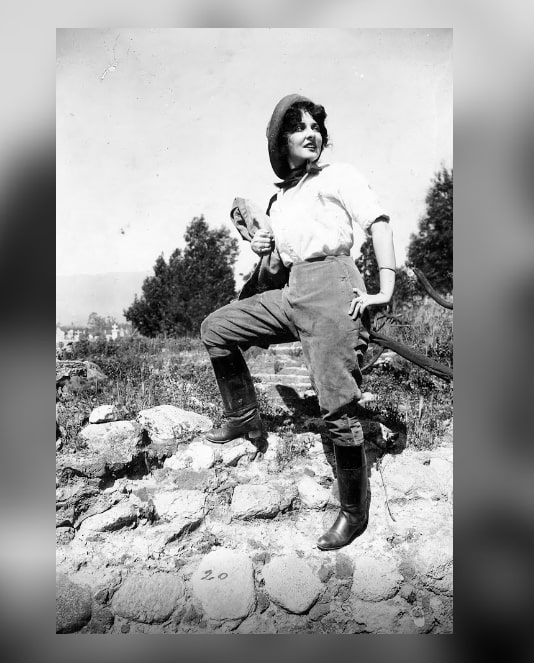 Lucretia del Valle
Lucretia del ValleCourtesy of David “Bodie” Bailey Family Archives | National Women’s History Museum
Daughter of Reginaldo del Valle, the first representative of Spanish-Mexican heritage to take office when elected to the state assembly in 1880, del Valle's notions of civic engagement and citizenship were heavily influenced by her upbringing. In 1911, California became the sixth state where women could vote equally with men. That same year, del Valle turned eighteen and saw women 21 years of age or older exercise their right to vote.
After gaining fame due to her role as Señora Yorba, del Valle moved to New York to enroll in Columbia University’s Department of Political Philosophy in 1917. Since New York had not yet passed women’s right to vote, she became disenfranchised. She put her studies into practice, converting her skills in theater performance into political action through public speaking, rallying other women on the east coast to fight for the right to vote. Here, she met her husband, professor Henry Grady, and spent the latter part of her life serving alongside his ambassadorial career addressing women’s rights internationally, heavily involved in California’s regional clubs, and serving as a Democratic National Convention delegate.
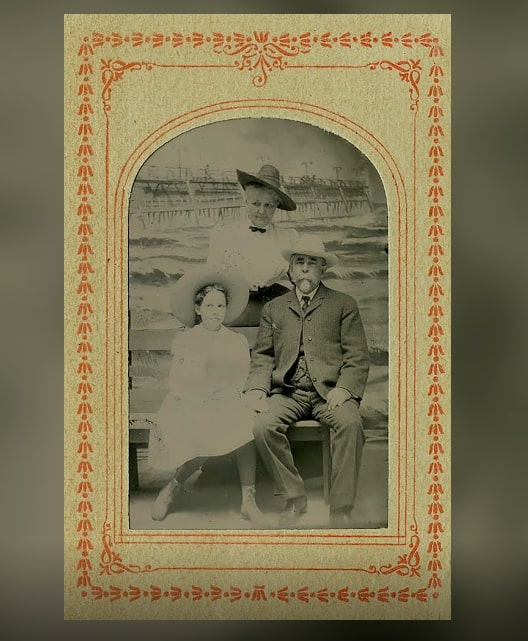 Lucretia Del Valle Family Portrait
Lucretia Del Valle Family Portraitby Long Beach Tin Type Gallery
National Women’s History Museum
The story of Lucretia del Valle is just one of numerous Hispanic bicultural political experiences that placed them in a duality of living life on the hyphen. For these Latina suffragists, their Hispanic cultural background shaped their notions of civic duty and citizenship in the United States. Their fight for representation was multifaceted, combining both their belief in women’s equal rights and their dedication to preserving their cultural heritage.
Del Valle’s life thus touches on themes common to a loosely shared narrative for Latina suffragists and sheds light on the reality that political activism took on many different forms. Del Valle’s work before 1920 and long after it, expand our notion that the suffrage movement was not constrained to one moment in history and that following ratification, women looked to enter traditionally male institutions to leverage their influence. It also reminds us how the timeline of suffrage varied greatly between states before reaching a national momentum and that Latinas played a direct role in advancing the movement.
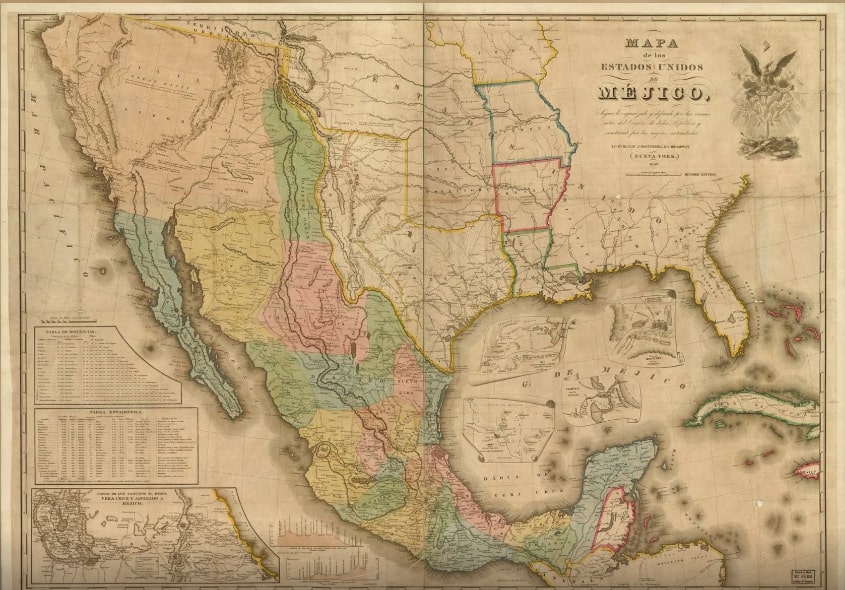 Map of Mexico Prior to Guadalupe Hidalgo - 1846
Map of Mexico Prior to Guadalupe Hidalgo - 1846Disturnell, John, 1801-1877 | National Women’s History Museum
Much like the broader history of the Women’s Suffrage Movement, the Hispanic and Latina experience dealt with complicated issues of race and class. Since the early settlement of U.S. and Mexico territories, colonists would hide their mestizo (Spanish/Indian) and mulatto (Spanish/African) identities, positioning themselves as “Spanish” to garner economic and social power. The practice of indentured servitude on the colonial frontier amongst people of Indian and African heritage further heightened this racial divide.
Del Valle’s position as the daughter of a prominent family that benefited from their position as “treaty citizens,” the first group of people considered ambiguously white who were able to hide their mestizo identity and gain collective citizenship in the United States after the Mexican-American War through the Treaty of Guadalupe Hidalgo, compounded her political influence. This reality was not the case for all Latina women, especially Latina’s of color, and the U.S. acquisition between 1848 and 1898 of heavily Hispanic territories that had embedded racial and class hierarchies had lasting effects that are intertwined with the history of women’s suffrage.
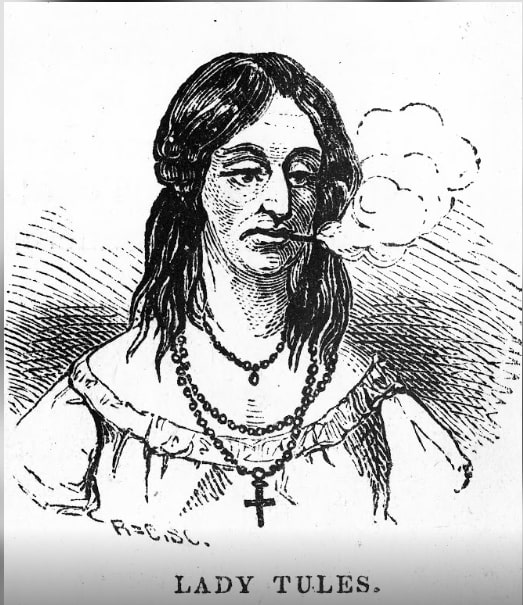 La Dona Tules (Gertrude Barcelo 1800 - 1852?) - 1853
La Dona Tules (Gertrude Barcelo 1800 - 1852?) - 1853Harper's Monthly Magazine | National Women’s History Museum
Pre-U.S. Occupation
Before U.S. occupation and the annexation of border territories such as New Mexico, Arizona, Texas, and California, women under Spanish and Mexican legal tradition enjoyed more rights compared to those under English common law. Under Spanish and Mexican law, women held the status of “persons” and were entitled to inherit and own land and property, to work and earn money, to fight in court, and to keep their maiden names when married. Under English common law, married women became feme covert (dead in the eyes of the legal system) and could not own property separate from their husbands. While under Mexican law, Spanish-speaking women sometimes fought land disputes in court, like their Euro-American counterparts, they had to tread a delicate balance between being a “lady” and assuming chores in the household.
A symbolic Nuevo Mexicana who benefitted from these rights was La Tules or Doña Gertrudis Barceló (1800-1850). Born in Sonora, Mexico, her family moved to the northern part of New Mexico after Mexico gained independence from Spain. Barceló gained status as a wealthy business owner through trade deals, investments, and gambling. She capitalized on the influx of Euro-Americans on the Santa Fe Trail before and during the Mexican-American War with her “Sala,” a local gambling saloon where the card game of Spanish Monte was played. Brought first from Spain to Mexico, the game of Monte gained popularity in the United States when troops introduced the practice of it during and after the War.
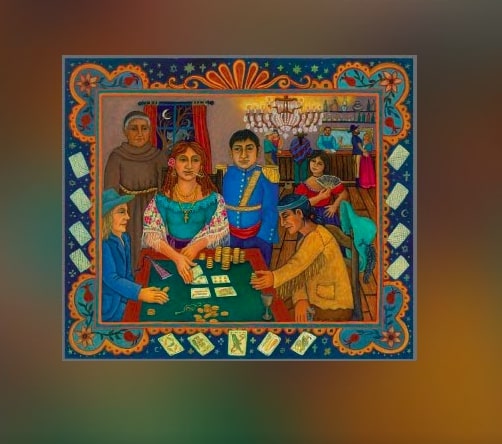 La Tules Diana Bryer Illustration
La Tules Diana Bryer IllustrationDiana Bryer | National Women’s History Museum
Marked by a time when interactions between Spanish-Mexicans and Euro-Americans were increasing, her Sala is credited for providing acculturation opportunities for Euro-Americans arriving in Santa Fe. At the saloon, these men were exposed to local music, habits, and humor, providing them with the firsthand opportunity to interact with the community.
As the U.S. Congress debated the annexation of Arizona, California, western Colorado, Nevada, New Mexico, Texas, and Utah, Barceló’s character was manipulated to justify occupation referencing Spanish-Mexican women’s “loose habits.” Negative images of Barceló and her saloon’s activities, along with other Spanish-speaking women, were used to legitimize the Euro-American conquest of the region and uphold anti-Mexican stereotypes. Journals and novels described Spanish-speaking women as “flashy and morally loose” who were obsessed with sinful behaviors such as gambling and drinking. The Spanish-Mexican population as a whole was depicted as semi-civilized people who would benefit from the effects of U.S. annexation. These ideas became known as “Manifest Destiny.”
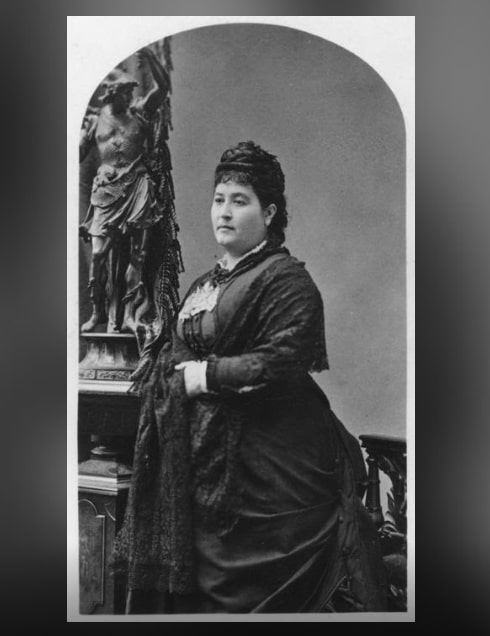 María Ruiz de Burton (before 1895)
María Ruiz de Burton (before 1895)National Women’s History Museum
With the conclusion of the Mexican-American War in 1848 and under the terms of the Treaty of Guadalupe Hidalgo, Mexican citizens in Arizona, California, western Colorado, Nevada, New Mexico, Texas, and Utah automatically became U.S. citizens by 1849. While these Mexican-American citizens were promised equal rights under the Treaty, they quickly saw themselves become second-class citizens. During this period, Mexican-Spanish families experienced a dramatic loss of their land and titles as they were relegated to lower-tier jobs such as farm labor, domestic work, and food processing. Women’s lives also changed drastically under U.S. occupation as they lost the rights previously held under Spanish and Mexican legal tradition, and entered the workforce for wages out of economic necessity.
Considered the first Mexican-American novelist, and a precursor to the Chicano/a movement, María Amparo Ruiz de Burton, captured these changes in two of her novels. Her first novel Who Would Have Thought It (1872) criticizes U.S. racism and imperialism and women’s marginality, and her second novel, The Squatter and the Don (1885), spoke out against Euro-American confiscation of Mexican lands and offered a Californio perspective on Manifest Destiny.
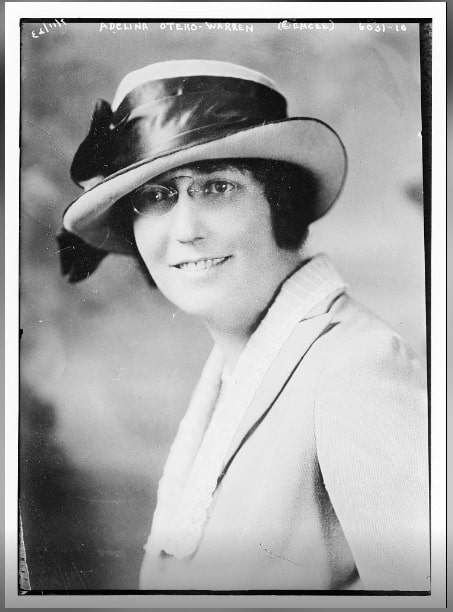 Adelina Otero-Warren - Jul 11, 1923
Adelina Otero-Warren - Jul 11, 1923Bain News Service, publisher | National Women’s History Museum
New Mexico
Influential Nuevo Mexicano Manuel B. Otero, father of Adelina “Nina” Otero-Warren, was a victim of these usurpations of land grants. He was killed by Anglos over a land dispute leaving Nina, two at the time, without a father. Seeing firsthand the effects of Anglo immigration into predominantly Spanish-Mexican territories, Otero-Warren understood, like other Hispanic politicians, the importance of political power in the state to defend her community’s property and culture.
Her maternal uncle played a key role during the New Mexico Constitutional Convention in 1910. To protect the Spanish language provisions and religious freedoms for Catholics, members of the constitutional convention made the Constitution hard to amend. Any changes required the votes of two-thirds of the legislators, followed by three-fourths voter approval in each county. Otero-Warren moved with her family to Santa Fe after her stepfather’s political appointment and used the relationships from her family's political careers to compound her influence in the state. She became the first female superintendent of schools in Santa Fe and took up a leading role in the fight for suffrage.
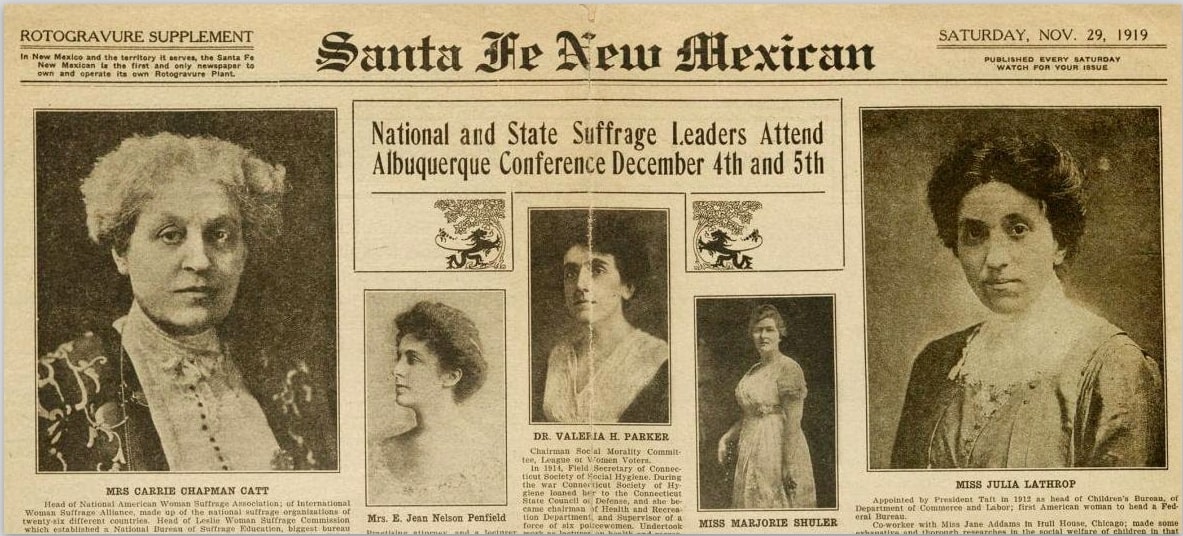 Santa Fe New Mexican Newspaper Clipping - Nov 29, 1919
Santa Fe New Mexican Newspaper Clipping - Nov 29, 1919Printed with permission from The Santa Fe New Mexican, November 2020 | National Women’s History Museum
Women across the country first began asserting their influence through Women’s Clubs formed in the 1890s during the Christian Temperance Movement. In the case of New Mexico, a small group of elite and politically connected Latinas made their way into these predominantly Anglo clubs. These women acted as patrons for Spanish-speaking women not represented in the system and advocated for legislation on their behalf.
Building off this experience, women saw the right to vote as an avenue to advocate for themselves and their children. They fought for full suffrage to be included in the New Mexico Constitution in 1912 but were unsuccessful. While the men of the convention had included women’s voting rights in school elections in the Constitution, women could not vote in other elections. Due to the provisions put in place at the convention that made the Constitution extremely hard to amend, suffragists in New Mexico saw the ratification of a national amendment as their way to obtaining the right to vote. Their efforts drew attention from the country’s prominent suffrage leaders.
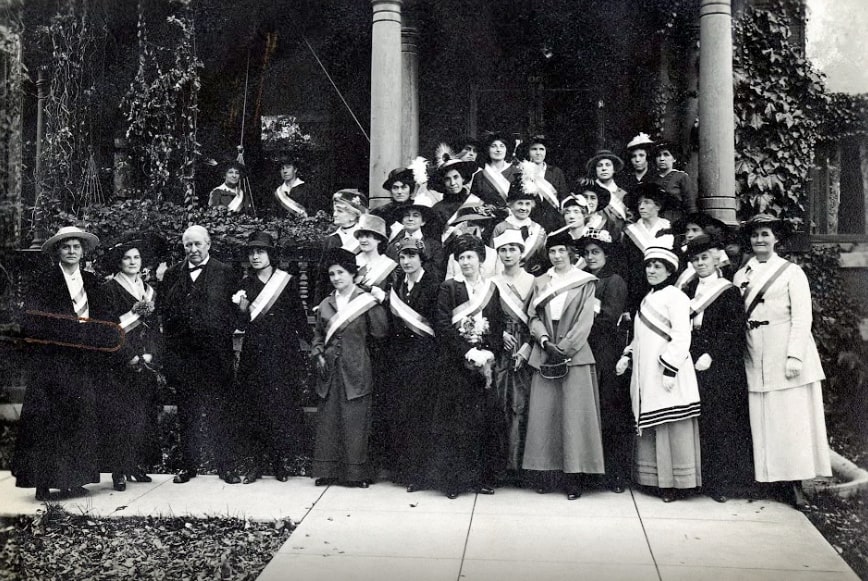 National Women's Party - 1915
National Women's Party - 1915National Woman's Party Collection Library of Congress | National Women’s History Museum
On October 21st, 1915, one hundred and fifty Anglo and Hispanic suffragists joined together on the streets of Santa Fe to make a statement in support of women’s suffrage. The march spanned the political geography of New Mexico’s capital city and drew out hundreds of people. The parade coincided with a visit from Mrs. Ella St. Clair Thompson, an organizer from the National Woman’s Party (NWP, known until 1916 as the Congressional Union). The National Women’s Party had been founded by Alice Paul and focused on securing an amendment that prohibited voting discrimination based on sex, whereas the National Women’s American Suffrage Association was led by Carrie Chapman Catt and focused on state ratification.
Recognizing the importance of working with Spanish-speaking women whose communities held a great deal of political power and influence, Paul and the Congressional Union first sent organizers and resources to New Mexico in 1914. They listened to leaders like Aurora Lucero-White Lea and Nina Otero-Warren who stressed to them the importance of addressing Spanish-speaking women.
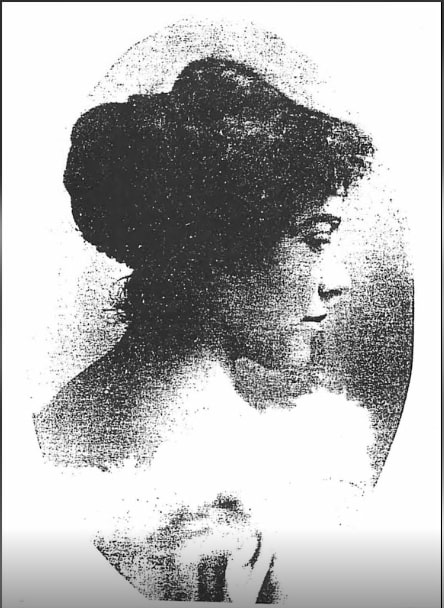 Aurora Lucero-White (1915)
Aurora Lucero-White (1915)National Women’s History Museum
The march concluded at the house of notorious anti-suffragist U.S. Senator Thomas Catron (R-NM). Four women – two Anglos and two Hispanic women - were designated to give speeches formally asking the Senator to support the federal amendment when he returned to Washington.
Aurora Lucero-White Lea, the daughter of the first New Mexico Secretary of State and one of the two Hispanic women chosen to give a speech, was a bi-lingual educator from Las Vegas, New Mexico. Like Otero-Warren, she was politically well-connected and recognized the need to appeal to Spanish-speaking women, who made up at least fifty percent of the female population in New Mexico. Speaking in Spanish, she pushed women to join the campaign and worked to distribute Spanish language promotional fliers. While Senator Catron declined the suffragist’s request, their cause gained great visibility in the capital and in the press coverage.
A year after the 1915 Santa Fe March, New Mexican women founded an official state branch of the NWP and elected Nina Otero-Warren as the state vice-chair. When the first chair stepped down, Otero-Warren took her place at Alice Paul's request.
The voices of these powerful sufragistas can be heard in this la votación corrido. Corridos are poetic ballads used to narrate rhetorically powerful stories and communicate socially relevant topics. They trace their origin to Mexico and are usually sung by men. However, with no known author, this corrido takes on a female perspective calling for women to advance their work in women’s clubs, gain the right to vote, and ultimately expand their role in society.
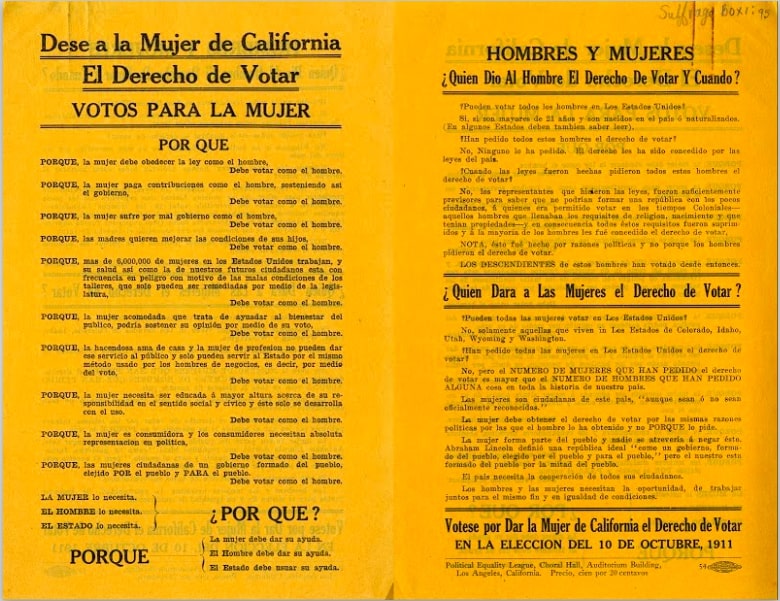 Dese a la mujer de California el derecho de votar - 1911
Dese a la mujer de California el derecho de votar - 1911Political Equality League, Ella Strong Denison Library; Claremont Colleges Digital Library | National Women’s History Museum
California
Californian suffragists, like Maria Guadalupe Evangelina de Lopez and Selina Solomons, adopted similar tactics to rally other Spanish-speaking women to the cause. In their case, however, their fight was focused on state ratification. California had placed Proposition 4, relating to Women’s Suffrage, on the ballot to go up for a vote in October of 1911.
A renowned educator, Maria Guadalupe Evangelina de Lopez was one of the youngest instructors to teach at UCLA and the very first confirmed Latina instructor at the university. Prior to her position at UCLA, Lopez taught English as a second language at Los Angeles High School and was a translator. She also took an active role in the Los Angeles region’s Votes for Women Club. During their 1911 rally pushing for the adoption of Proposition 4, she gave her speech in Spanish and worked to translate suffrage materials into Spanish for the campaign.
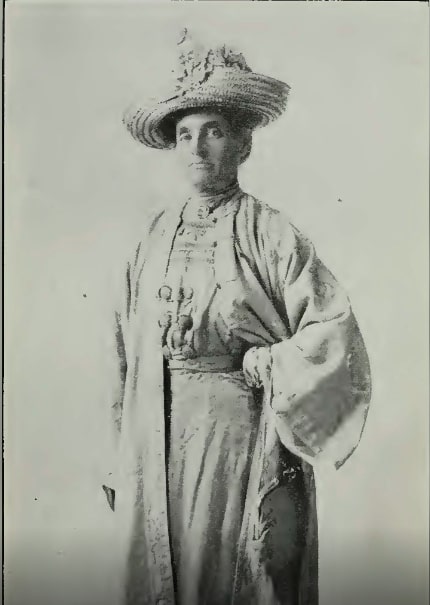 Selina Solomons Portrait (1911)
Selina Solomons Portrait (1911)by The New Woman Pub. Co.
National Women’s History Muse
Working alongside Lopez for the cause was Selina Solomons, a Sephardic Jew from a middle-class family who traced their ancestry to Spain and England. When California failed to pass the right to vote in 1896, Solomons focused her outreach on middle and lower-class voters. She founded the Votes for Women Club in 1910 in downtown San Francisco which aimed to educate women from different classes on the suffrage movement. She led an active campaign in 1911 with the women at the club and encouraged working class women to get involved with suffrage.
On October 10, 1911, California passed Proposition 4 and became the sixth state where women gained the right to vote. In 1912, Solomons published How We Won the Vote in California: a true story of the campaign of 1911, which outlined the successful process that earned women the right to vote in California from early-stage lobbying to fundraising efforts.
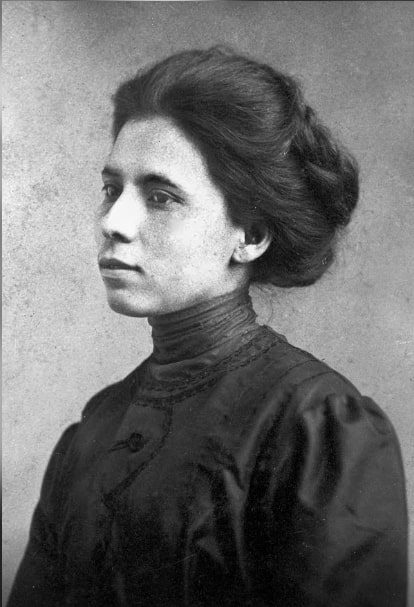 Jovita Idár Portrait - 1905
Jovita Idár Portrait - 1905General Photograph Collection/UTSA Libraries Special Collections via NYT | National Women’s History Museum
Texas
Born in Laredo, Texas, Jovita Idár was exposed to journalism and political activism from an early age. Her father, Nicasio, was a newspaper editor for La Crónica, the main source of news and activism for Mexican-American rights in the region. In 1911, her family hosted the First Mexican Congress intended to unify Mexican-Americans across the border to fight for injustice and equality. Later that year, Idár wrote an article for La Crónica supporting women’s suffrage and encouraging women to vote, before founding La Liga Femenil Mexicanista (the League of Mexican Women).
Upon returning to Texas after serving as a nurse during the Mexican Revolution, she worked at the El Progreso newspaper. Her experience in Mexico propelled her to write an article protesting President Woodrow Wilson’s decision to send U.S. troops to the border. When the United States Army and Texas Rangers showed up to the offices of El Progreso to shut it down after the publication of her article, Idár blocked the front door to inhibit them from going in. While the Rangers eventually returned when she wasn’t there to destroy the printing press and shut it down, Idár is credited for her symbolic statement.
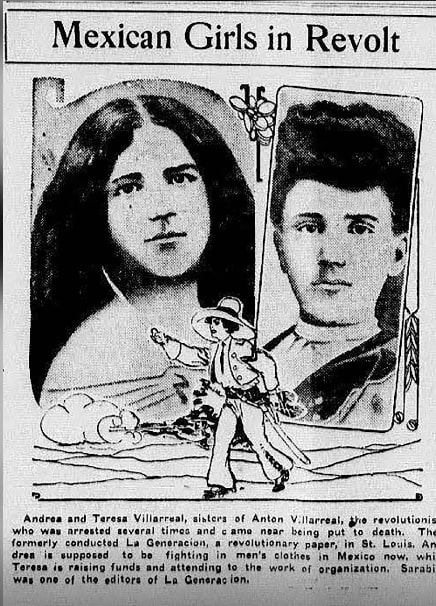 Teresa and Andrea Villarreal - Mar 19, 1919
Teresa and Andrea Villarreal - Mar 19, 1919The Daily Missoulian | National Women’s History Museum
The work of Latina suffragists in Texas was intertwined with the Mexican Revolution and its impacts on Mexican-American citizens. Latinas took to the press to speak out about racism, the Revolution, segregation, and the advancement of women’s rights. Experiencing firsthand the impacts of the Mexican Revolution, sisters Andrea and Teresa Villarreal were activists and political organizers who fled their hometown of Nuevo Leon, Mexico, because of their support for the Mexican Liberal Party (Partido Liberal Mexicano, or PLM). Eventually making their way to San Antonio, Texas, they founded La Mujer Moderna, a feminist newspaper. Through this platform, they advanced their ideas on social, political, and economic reforms as they related to conditions for Mexican-Americans in Texas and advancing women’s rights.
In May of 1919, a referendum to amend the Texas Constitution to grant full suffrage to women, while disenfranchising noncitizen aliens, went up to vote. It ultimately failed and the Texas Legislature ratified the 19th amendment in June of that year, making it the ninth state, and the first southern state, to grant women the right to vote.
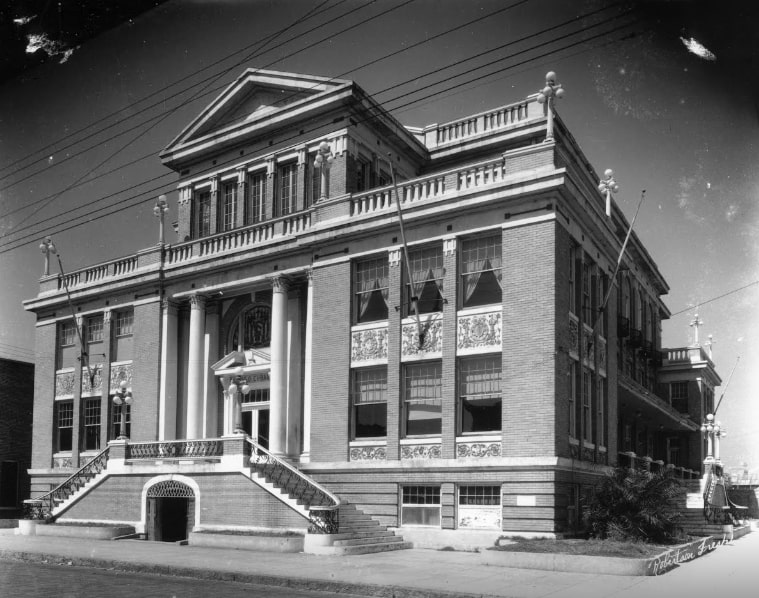 Centro Cubano
Centro CubanoRobertson and Fresh Collection of Tampa Photographs | Tampa, Florida | National Women’s History Museum
Florida
Over a thousand miles away, the fight for women’s suffrage within the Hispanic and Latino community in Tampa, Florida, was intertwined with unionization around labor conditions in the cigar industry. Civic participation first originated in ethnic clubs and mutual aid societies in neighborhoods, such as Ybor City, which provided social and cultural assistance. An Afro-Cuban ethnic club, La Unión Martí-Maceo was the first to create a comité de damas (women’s committee) tasked with organizing social functions.
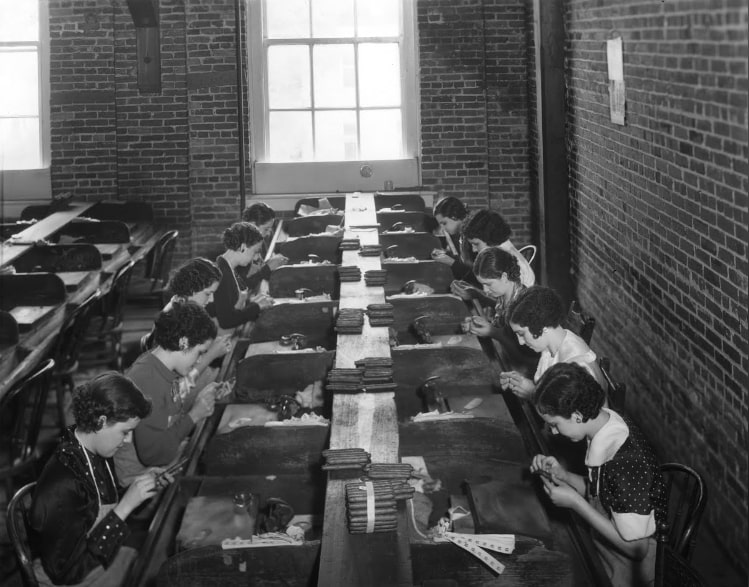 Women at work in a cigar factory - 1934
Women at work in a cigar factory - 1934by Burgert Brothers, University of South Florida Library | Tampa, Florida | National Women’s History Museum
These clubs were made up of working-class people who advocated for their vision of a well-ordered society. Their work in factories, listening to the news provided by the reader or “lector,” informed them of the political themes of the day. Strikes over working conditions began in the early 1880s and continued throughout the 1900s. While the strikes provided a ground for cooperation across racial and ethnic divides, white Cubans' acceptance of Jim Crow outside the shop floor and union hall was a stark contrast as they sought to differentiate themselves from Cubans of color. During more peaceful periods, the ethnic clubs solidified ethnic and racial bonds and Latinas reverted to sex-specific arenas.
With the transformation of the workforce due to ongoing immigration and the rise of single-sex organizations in African American and Anglo Communities, room for activism emerged for Hispanic activists.
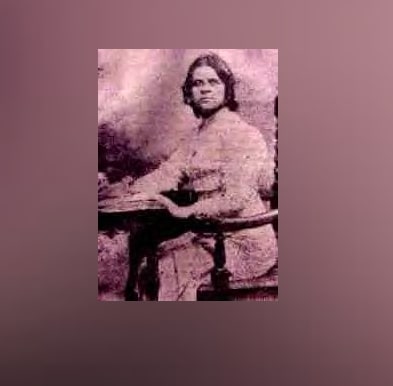 Luisa Capetillo Headshot
Luisa Capetillo HeadshotNational Women’s History Museum
Puerto Rico
Puerto Rican feminist Luisa Capetillo mirrored these same concerns experienced in Tampa and organized around her belief of the inextricable tie between class struggles and women’s suffrage. Born in Arecibo to French and Spanish parents, she grew up during the conclusion of the Spanish-American War of 1898 that ended with Spain ceding the colony of Puerto Rico to the United States. Like other women on the island, Capetillo took jobs in tobacco processing and needlework for U.S. and Puerto Rican companies. With the rise of U.S. corporate agriculture, men experienced losses of wages and women became instrumental in providing for the family.
Capetillo’s view of feminism differed from middle-class suffragists during the time as she believed that women’s fight for equal rights was no different than the fight for worker’s rights since education was the catalyst for any social change. Even in Puerto Rico, she differed in opinion from other professional and upper-class Latinas who believed in suffrage for literate and educated women only. Her focus on class struggle rejected the idea of limited suffrage based on education and income.
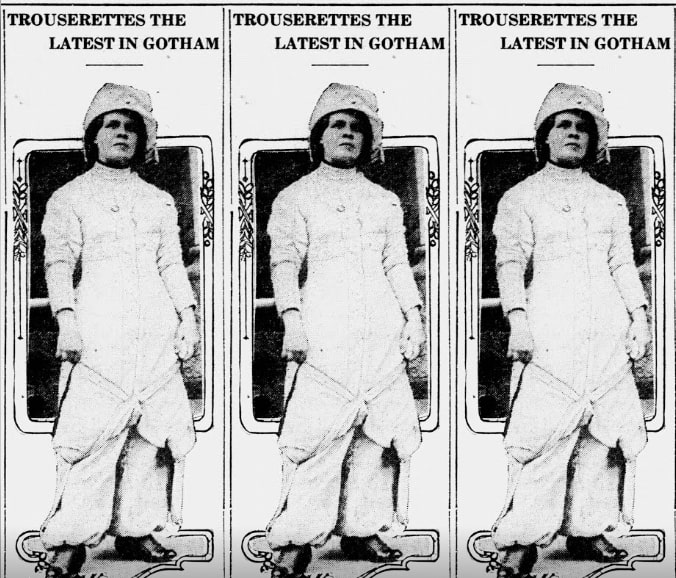 Luisa Capetillo Collage - Jul 1, 1912
Luisa Capetillo Collage - Jul 1, 1912The Richmond palladium and sun-telegram, Chronicling America: Historic American Newspapers. Lib. of Congress | National Women’s History Museum
Capetillo eventually rose to the prestigious position of a lectora in the tobacco factories and joined unions to advocate for better working conditions. She played an important role in the Free Federation of Workers (Federación Libre de Trabajadores, or FLT), the anarcho-syndicalist union of Puerto Rican cigar workers, where she was a correspondent for La Unión Obrera. In 1908, the annual convention of FLT became the first organization of any kind in Puerto Rico to demand women’s enfranchisement; and the organization regularly passed resolutions calling for improvements in women’s education, legal, and political rights.
In 1911, she moved to New York City where she organized alongside workers of the city’s cigar factories and was one of the only females ever to read as a lectora there. Here, she published her most famous collection of essays Mi Opinion sobre las libertades, derechos y deberes de la mujer (My opinion on the liberties, rights, and needs of women). In 1912, she moved to Tampa where she continued her work as a lectora and journalist. Her time in Ybor City, a neighborhood in Tampa, working alongside Cuban, Italian, African-American, and Spanish cigar workers influenced her 1916 collection, Influencias de las ideias modernas (Influences of modern ideas). In 1915 she traveled to Cuba and participated in a sugarcane worker's strike. Here, she was arrested for "causing a scene” after going against current cultural and social codes and wearing pants in public. She was later set free and returned to Puerto Rico where she continued organizing until her death in 1922.
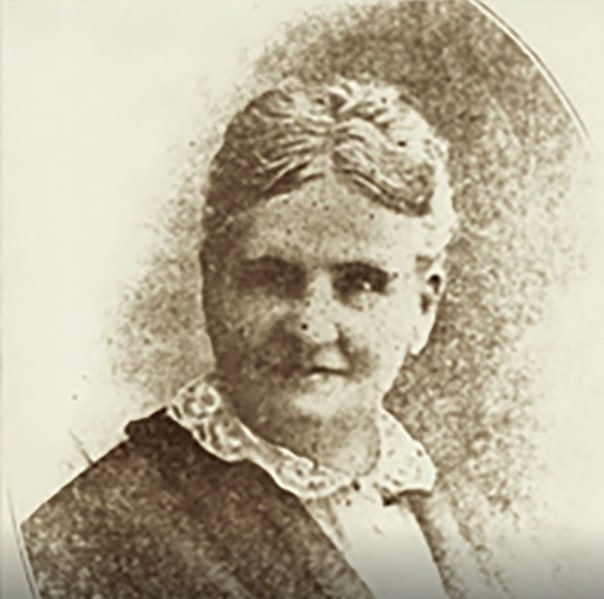 Ana Roque de Duprey
Ana Roque de Dupreyby General Archives of Puerto Rico
National Women’s History Museum
In 1917, Congress signed the Jones-Shafroth Act, making all Puerto Ricans U.S. citizens without rescinding their Puerto Rican citizenship. However, citizenship came with no promise of statehood or federal voting rights. Calls for women’s suffrage had begun decades earlier with the work of Luisa Capetillo and Ana Roqué de Duprey. Ana, an educator, founded La Mujer in 1898, the country’s first “women only” magazine, and dedicated her career to providing education for girls on the island and preparing potential young teachers for their examinations. Coinciding with the year that Puerto Ricans gained US citizenship, Ana founded the Puerto Rican Feminist League and focused her efforts on women's voting rights for the following years.
When a 1919 bill for women’s suffrage failed, Genara Pagán revivified the call for suffrage in 1920, after the passage of the 19th Amendment, when she attempted to register to vote and was rejected. Puerto Rican suffragists feverously continued their fight, pushing for bills to enfranchise women on the island. In 1929, the Puerto Rican legislature extended voting rights to the small group of women who could read and write. It would not be until 1935 that all Puerto Rican women gained access to the ballot through local laws rather than constitutional reform at the federal level.
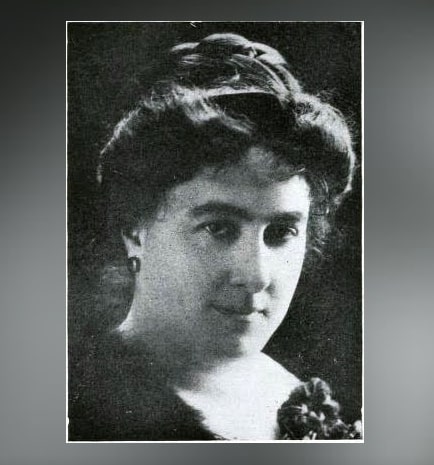 Paulina Luisi (1921)
Paulina Luisi (1921)by William Belmont Parker
National Women’s History Museum
Pan Hispanic Movement
Echoing Capetillo’s line of activism, the Pan-Hispanic feminist movement in Latin America also differed from the North American feminist movement. For Latinas outside mainland U.S., their activism was not concerned solely with the vote and equal rights for women under the law, but also intended to challenge multiple forms of political, economic, and social oppression and violence.
While Doris Stevens of the National Women's Party and chair of the Inter-American Commission of Women, would later push for the adoption and support for the Equal Rights Amendment in the United States and the inclusion of such language into international law, Latin American suffragists such as Paulina Luisa from Uruguay, Bertha Lutz from Brazil, Clara Gonzalez from Panama, Ofelia Dominguez Navarro from Cuba, and Marta Vergara from Chile would create their own strand of “practical feminism” that focused on an embodiment of human rights.
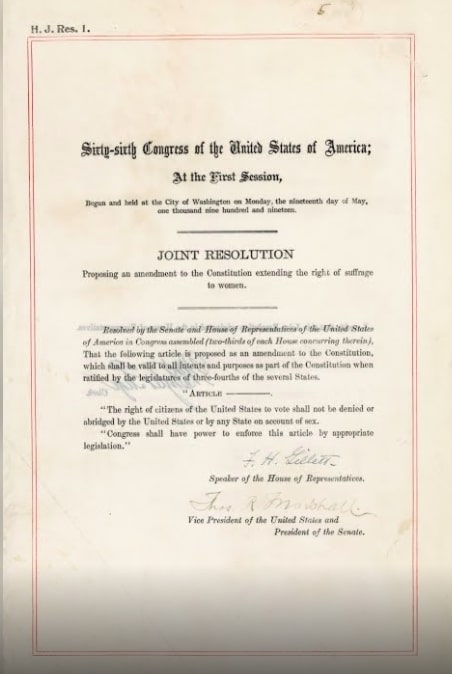 Nineteenth Amendment to the United States Constitution - Jun 4, 1919
Nineteenth Amendment to the United States Constitution - Jun 4, 1919National Archives and Records Administration. Office of the Federal Register. 4/1/1985 - Organization Authority Record, Department of State. 9/1789 - Organization Authority Record | National Women’s History Museum
19th Amendment
In May of 1918, New Mexican suffragist Cora Armstrong Kellam met with President Wilson as a delegate from the Women’s Committee on the Council of National Defense and appealed to women’s efforts in the war to lobby the movement. Her meeting emphasized how women in the West were growing restless waiting for the long-delayed passage and urged him to act. A year later, Congress passed the 19th amendment in June of 1919.
While these sufragistas in New Mexico had been doing a lot of lobbying in time for the legislative session in February of 1920, some members of the party wavered at the last minute due to an anti-suffragist movement that Hispanic men were joining. Nina Otero-Warren played a key role in ensuring that her state legislature ratified the 19th Amendment in February 1920, fiercely lobbying and using her new position as chair of the Republican state women’s committee to caucus with legislators and discipline their votes. New Mexico became the 32nd state to ratify, helping reach the 36 states needed.
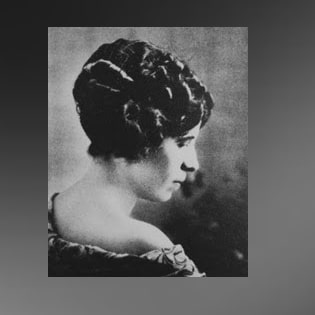 Soledad C. Chacon (1923 - 1926)
Soledad C. Chacon (1923 - 1926)National Women’s History Museum
Post-19th Amendment
With the ratification of the 19th Amendment, newly enfranchised women looked to enter predominantly male institutions to exercise their influence. In New Mexico, Democrat and Republican parties nominated women to run for office. The Republicans nominated Nina Otero-Warren for the Congressional seat in 1922. While she beat the male incumbent in the primary, she lost in the main election. Nevertheless, her campaign made national headlines and counted as a historic moment.
That same year, Democrats in New Mexico nominated two women for state office. The candidate for Secretary of State was Soledad Chávez de Chacón, a Hispanic woman. Chávez de Chacón won the election becoming the first Latina elected to statewide office in the United States, and the first woman in the nation to win an election for that office. She would serve two terms through 1926 and in 1934 was elected to New Mexico’s House of Representatives, becoming the fourth Latina to hold that office.
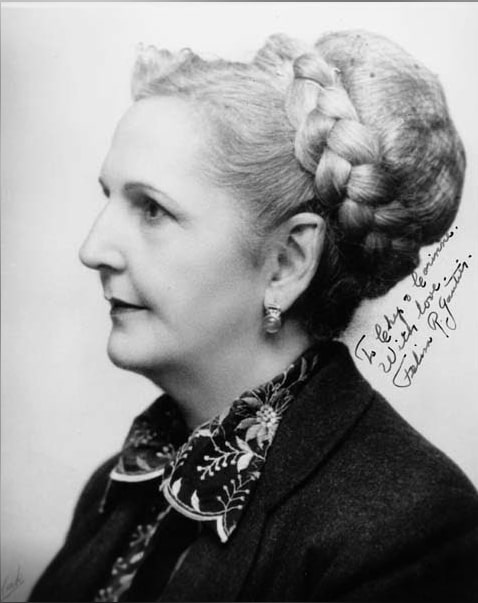 Doña Felisa
Doña FelisaFundación Felisa Rincón de Gautier | National Women’s History Museum
In 1946, San Juan, Puerto Rico elected Felisa Rincón de Gautier, widely known as Doña Fela, as the first female mayor in any capital city in the Western Hemisphere. Gautier was active in the campaign to win Puerto Rican women the right to vote, and when women who passed literacy tests were able to vote in their first major election in 1932, she was the fifth woman on the island to register. Through her time as mayor of San Juan, Gautier focused her work on social causes advocating for women’s rights, child-care programs, centers for the elderly, and legal aid for the poor. Her time in office led to extraordinary progress in the areas of public welfare, public works, expanding educational and cultural opportunities, as well as strengthening relations with the U.S. and Latin America.
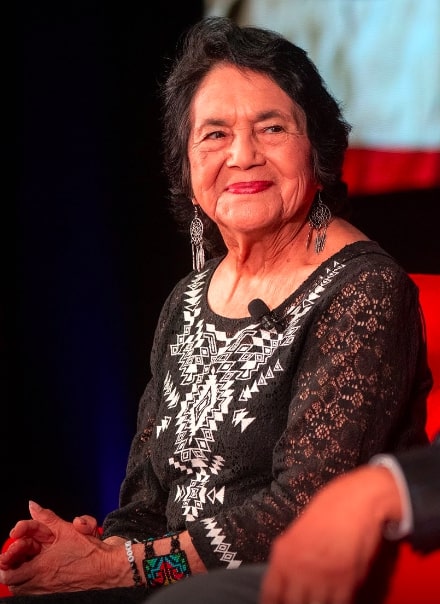 Dolores Huerta (Mar 8, 2019)
Dolores Huerta (Mar 8, 2019)by Jay Godwin
National Women’s History Museum
In addition to running for public office, Latinas have organized through their work in political advocacy organizations such as the League of United Latin American Citizens (LULAC), an important civil rights organization for Mexicans-Americans in the southwest founded in Texas in 1929, and the Community Service Organization (CSO), a statewide confederation that focused on registering voters and improving public services founded in California in 1947. Following the formation of LULAC, feminist and civil rights activist Adela Sloss-Vento pledged herself to the organizations cause before women could join and played an active role in raising funds for the first lawsuit against segregation, Del Rio ISD v. Salvatierra. In 1933, when LULAC finally allowed women to join as members, Sloss-Vento co-founded the Ladies LULAC council.
Latinas also took up prominent roles as labor rights activists, fighting for working class-community rights. Luisa Moreno, an immigrant from Guatemala, dedicated her life to organizing around unfair labor practices and exploitation in pay. Alongside Josefina Fierro, a native of Mexicali, she organized The Spanish-Speaking People’s Congress (El Congreso de Pueblos de Habla Española) in 1939. Following Luisa Moreno’s lead, Dolores Huerta lobbied for improved labor conditions for farmworkers. She co-founded the National Farm Worker’s Association (NFWA), later known as United Farm Workers (UFW) in 1962 alongside César Chavez. Their work would lend itself to the rise of the Chicana feminist movement in the late 1960s and women’s organizations through the La Raza Unida Party (LRUP).
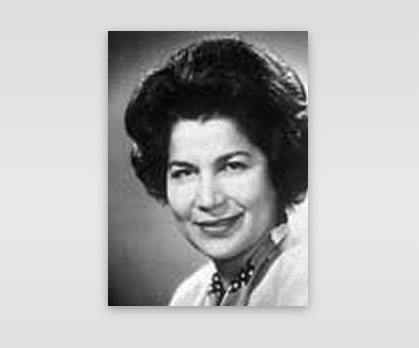 Romana Acosta Bañuelos - Dec 17, 1971
Romana Acosta Bañuelos - Dec 17, 1971by Office of the Treasurer | National Women’s History Museum
In 1970, seeking to repay the work of the Republican National Hispanic Assembly in his election, President Richard Nixon picked Romana Acosta Bañuelos to the post of U.S. Treasurer. Bañuelos was born in Miami, Arizona, in 1925 to Mexican immigrants. After her family was deported in 1933 during the Great Depression, Bañuelos returned to the U.S. in 1943 and started her own tortilla factory in downtown Los Angeles. The rapid success of her tortilla factory led to creation of Ramona’s Mexican Products and in 1963, she founded the Pan-American National Bank in East Los Angeles to help struggling Latinos in the region.
Bañuelos was confirmed as the nation’s 34th treasurer, the first Latina in the position in U.S. history, on December 17th, 1971. Through her appointment, she became the highest-ranking Mexican-American in the government. She would lead the way for other Latinas, such as Katherine Ortega and Catalina Vásquez Villalpando, and more recently Rosie Rios, to assume the same position as treasurers of the United States.
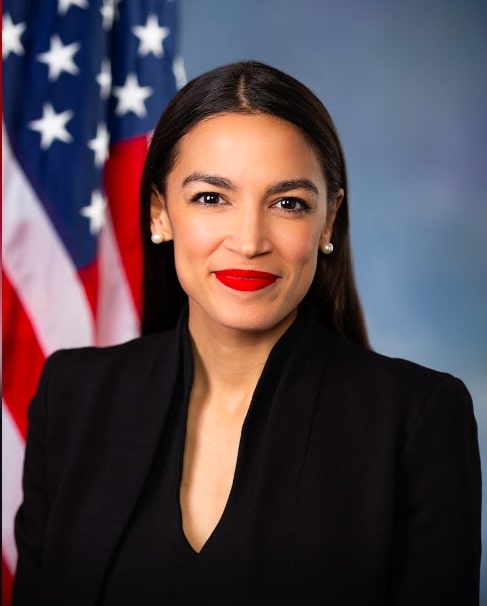 Alexandria Ocasio-Cortez - Nov 30, 2018
Alexandria Ocasio-Cortez - Nov 30, 2018Franmarie Metzler; U.S. House Office of Photography | National Women’s History Museum
Latinas from all over the country have continued to organize in numbers, shattering glass ceilings by making history through their ascension to positions of leadership. In New Mexico, Susana Martinez was elected the first female governor of the state and the first Latina governor in the country in 2010. In Nevada, Catherine Cortez Masto became the first Latina to serve in the US Senate in 2017. Most recently, in Arizona, Regina Romero became the first and only Latina mayor in the continental United States in 2019. In addition, numerous other incredible Latinas are serving in local and state positions, organizations, and corporations, advocating for their voice and the voice of their community to be heard.
The rise of Congresswoman Alexandria Ocasio-Cortez only reminds us of the sheer power that Latinas have in shaping the national agenda and guiding the political themes of the day. Since the inception of this country to obtaining the right to vote and beyond, Latinas have consistently positioned themselves at the forefront of political change, all while embracing their heritage and culture. Their hyphenated identity is one of power and pride. It is time that we do justice to their history by amplifying their work and celebrating their stories as uniquely American.
Credits
Exhibit curated and written by Mariana Brazão, Public History Research Intern, Fall 2020. Edited by Dr. Cathleen D. Cahill, Exhibit Advisor.
Works Cited:
Alexander, Kerri Lee. “Jovita Idár.” National Women's History Museum, 2019, www.womenshistory.org/education-resources/biographies/jovita-idar.
“Bañuelos, Romana Acosta.” Encyclopedia.com, Encyclopedia.com, 29 Nov. 2020, www.encyclopedia.com/history/encyclopedias-almanacs-transcripts-and-maps/banuelos-romana-acosta.
Bennett, Candice. “Selina Solomons (1862–1942).” Turning Point Suffragist Memorial, 14 Jan. 2019, suffragistmemorial.org/selina-solomons-1862-1942/.
Brown-Coronel, Margie. “‘Born a Leading Lady’: The Political Trajectory of Lucretia Del Valle.” The Journal of the Gilded Age and Progressive Era, vol. 19, no. 4, 2020, pp. 623–633., doi:10.1017/S1537781420000353.
Cadava, Geraldo. The Hispanic Republican: The Shaping of an American Political Identity, From Nixon to Trump. ECCO, 2020.
Cahill, Cathleen D. Recasting the Vote: How Women of Color Transformed the Suffrage Movement. The University of North Carolina Press, 2020.
Cahill, Cathleen D. “Suffrage in Spanish: Hispanic Women and the Fight for the 19th Amendment in New Mexico.” Women's Vote 100, Women's Suffrage Centennial Commission, 25 June 2020, www.womensvote100.org/the-suff-buffs-blog/2020/6/24/suffrage-in-spanish-hispanic-women-and-the-fight-for-the-19th-amendment-in-new-mexico.
Cho, Hahna. “Luisa Capetillo: Feminism and Labor In Puerto Rico.” BackStory, 7 Sept. 2018, www.backstoryradio.org/blog/luisa-capetillo-feminism-and-labor-in-puerto-rico/.
Dominguez, Orae. “María Gertrudis Barceló: ‘Doña Tules.’” New Mexico History, 24 Oct. 2013, newmexicohistory.org/2013/10/24/maria-gertrudis-barcelo-dona-tules/.
“Felisa Rincon De Gautier Museum, San Juan.” PuertoRico.com. PuertoRico.com, November 1, 2018. https://www.puertorico.com/attractions/museums/felisa-rincon-de-gautier/.
Gonzalez, Deena J.. Refusing the Favor : The Spanish-Mexican Women of Santa Fe, 1820-1880, Oxford University Press, Incorporated, 1999. ProQuest Ebook Central, https://ebookcentral-proquest-com.proxy01.its.virginia.edu/lib/uva/detail.action?docID=241272.
Hamilton, Megan. “Ana Roque De Duprey, Puerto Rico’s Astonishing Educator and Suffragist Hero.” History Hustle, 1 June 2020, historyhustle.com/ana-roque-de-duprey-educator-suffragist-leader/.
Hewitt, Nancy A.. Southern Discomfort: Women's Activism In Tampa, Florida, 1880s-1920s. University of Illinois Press, 2001.
Hurst, Catherine. Women of the West, Part 3, 9 Dec. 2007, choosing-santa-fe.blogspot.com/2007/12/women-of-west-part-3.html.
Kamerick, Megan. “New Mexico and The Vote Podcast.” New Mexico PBS, KNME-TV, PBS, 21 July 2020, www.newmexicopbs.org/new-mexico-and-the-vote-podcast/.
Lozano, Rosina. An American Language: The History of Spanish in the United States. University of California Press, 2018.
Macpherson, Anne S. “The 19th Amendment Didn't Grant Puerto Rican Women Suffrage.” The Washington Post, WP Company, 26 Aug. 2020, www.washingtonpost.com/outlook/2020/08/26/19th-amendment-didnt-grant-puerto-rican-women-suffrage/.
Marino, Katherine M. Feminism for the Americas: The Making of an International Human Rights Movement. University of North Carolina Press, 2019.
McNamara, Sarah. “Borderland Unionism: Latina Activism in Ybor City and Tampa, Florida, 1935-1937.” Journal of American Ethnic History, vol. 38, no. 4, 2019, pp. 10–32. JSTOR, www.jstor.org/stable/10.5406/jamerethnhist.38.4.0010.
Medina, Jennifer. “Overlooked No More: Jovita Idár, Who Promoted Rights of Mexican-Americans and Women.” The New York Times, The New York Times, 7 Aug. 2020, www.nytimes.com/2020/08/07/obituaries/jovita-idar-overlooked.html.
Murdock, Michelle. “Maria Amparo Ruiz De Burton.” Recovering 19th-Century American Women Writers, 29 Apr. 2015, blogs.stockton.edu/litrecovery/maria-amparo-ruiz-de-burton/.
Orozco, Cynthia E. Agent of Change: Adela Sloss-Vento, Mexican American Civil Rights Activist and Texas Feminist. University of Texas Press, 2020.
Orozco, Cynthia E., and Jazmin León. “Vento, Adela Sloss (1901–1998).” Texas State Historical Association, Handbook of Texas Online, www.tshaonline.org/handbook/entries/vento-adela-sloss.
Pace, Eric. “Felisa Rincon De Gautier, 97, Mayor of San Juan.” The New York Times, The New York Times, 19 Sept. 1994, www.nytimes.com/1994/09/19/obituaries/felisa-rincon-de-gautier-97-mayor-of-san-juan.html.
Pacheco, Carmella Scorcia. “A Centennial Glimpse into New Mexico's Suffrage Movement through ‘El Corrido De La Votación.’” Smithsonian Center for Folklife and Cultural Heritage, Smithsonian, 20 Sept. 2019, folklife.si.edu/magazine/new-mexico-suffrage-movement-corrido-de-la-votacion.
Prieto, Laura. “Votes for Colonized Women.” Process: a Blog for American History Search for: Processhistory, 28 May 2020, www.processhistory.org/prieto-votes-colonized/.
Reichert, Sabrina. “Latinx Women in the U.S. Women's Suffrage Movement.” Women's Museum of California, 3 Aug. 2020, womensmuseum.wordpress.com/2020/05/22/latinx-women-in-the-u-s-womens-suffrage-movement/.
Ruíz, Vicki, et al. Latinas In the United States: A Historical Encyclopedia. Indiana University Press, 2006.
Saul, Abby. “Sept. 14, 1911: El Primer Congreso Mexicanista Convenes in Laredo.” Zinn Education Project, www.zinnedproject.org/news/tdih/jovita-idar.
Scaglione, Joe "City in Turmoil: Tampa and the Strike of 1910," Sunland Tribune: Vol. 18 , Article 6., 1992, Available at: https://scholarcommons.usf.edu/sunlandtribune/vol18/iss1/6.
Spiegel, Taru. “Luisa Capetillo: Puerto Rican Changemaker.” 4 Corners of the World: International Collections and Studies at the Library of Congress, Library of Congress, 18 Nov. 2019, blogs.loc.gov/international-collections/2019/11/luisa-capetillo-puerto-rican-changemaker/.
“Teresa Villareal.” Brooklyn Museum: Teresa Villareal, www.brooklynmuseum.org/eascfa/dinner_party/heritage_floor/teresa_villareal.
Vaughn, Chelsea K. “The Joining of Historical Pageantry and the Spanish Fantasy Past: The Meeting of Señora Josefa Yorba and Lucretia Del Valle.” The Journal of San Diego History, vol. 57, no. 4, 2011, pp. 213–235., sandiegohistory.org/journal/v57-4/v57-4vaughn2.pdf.
